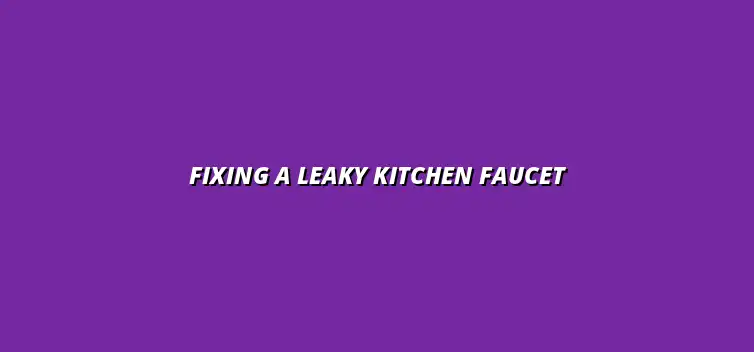
Fixing a Leaky Kitchen Faucet
Understanding Kitchen Faucet Leaks: Causes and Implications
Kitchen faucet leaks can be a small yet annoying problem in many households. They often start as a minor drip, but if left unchecked, they can turn into a bigger issue. Understanding the common causes of these leaks and their implications can help you address them before they escalate.
Leaks can arise from various sources, and each one has its implications for your home. By identifying these causes, you can take steps to fix them quickly. In this section, we will explore the most common causes of faucet leaks and the potential impacts they can have on your home.
Identifying Common Causes of Faucet Leaks
When it comes to faucet leaks, there are a few typical culprits. By recognizing these issues, you can often pinpoint the problem without needing a professional. Here are some common causes of faucet leaks:
- Worn-Out Washers and O-Rings: These small components can wear down over time, leading to leaks.
- Corroded Valve Seats: If the valve seats rust, they can cause water to leak out.
- Loose Connections and Fittings: Sometimes, the problem is as simple as loose fittings that need tightening.
Worn-Out Washers and O-Rings
Washers and O-rings are crucial for creating a tight seal in your faucet. Over time, they can become less effective due to constant usage and water exposure. If you notice water leaking around the handle or spout, it might be time to replace these parts. Replacing worn washers and O-rings is usually straightforward and can save you from more significant issues down the line. For more detailed guidance on fixing kitchen sink leaks yourself, check out this helpful DIY guide.
Always keep a few spare parts on hand to make quicker repairs when needed!
Corroded Valve Seats
The valve seat is where the faucet connects with the spout. If this area gets corroded, it can lead to leaks. Corrosion often happens due to water sitting in one spot for a long time.
To prevent this, regularly clean around the valve seat to keep it in good condition. If you discover corrosion, you may need to replace the valve seat entirely to stop the leak and ensure smooth operation.
Loose Connections and Fittings
Loose connections or fittings can easily happen over time, especially if the faucet is frequently used. If you hear a dripping sound or notice water pooling under the sink, it might be worth checking these connections. Tightening loose components can often resolve the leak. However, make sure not to overtighten, as that can cause damage. Regularly checking your faucet fittings can help maintain its integrity!
The Impact of a Leaky Faucet on Your Home
Ignoring a leaky faucet can lead to several issues beyond just the annoyance of dripping water. It's essential to understand how a small leak can impact your home overall. Here are some potential complications:
- Water Waste and Increased Bills: Even a slow drip can lead to a significant amount of water waste over time, which will reflect in your utility bills.
- Potential Damage to Fixtures and Cabinets: Constant water exposure can cause damage to your cabinetry and other fixtures, leading to costly repairs.
Water Waste and Increased Bills
One of the most noticeable effects of a leaky faucet is the water waste it creates. A single drip can waste gallons of water over a month, adding extra costs to your water bill. This not only affects your wallet but is also detrimental to the environment!
Being proactive in fixing leaks can save you money and conserve water. It’s a win-win if you take action quickly!
Potential Damage to Fixtures and Cabinets
Water that drips from a leaky faucet doesn’t just disappear. It can damage the surrounding cabinetry, cause mold growth, and lead to structural issues over time. Early detection and repair of faucet leaks can help prevent extensive damage. If you're struggling with blocked drains which can sometimes be linked to leaks, you might find this article on kitchen drain blockages helpful.
Keeping an eye on your kitchen fixtures and addressing leaks promptly can save you from more expensive repairs down the road. Always inspect your faucet regularly to catch issues before they worsen!
Effective Strategies for Repairing a Leaky Kitchen Faucet
Fixing a leaky kitchen faucet can seem daunting, but with the right approach, it's quite manageable! Understanding the specific type of faucet you have and gathering the right tools can make the process smoother. Let’s dive into how to effectively tackle these repairs and prevent future leaks.
Gathering Necessary Tools and Materials
Before starting any repair, it's crucial to have the right tools on hand. This will save you time and frustration, allowing you to focus on fixing the leak rather than running back and forth to gather supplies. Here’s what you typically need:
- Adjustable wrenches
- Screwdrivers (flathead and Phillips)
- Pliers
- Teflon tape
- Replacement washers, O-rings, or cartridges
Essential Repair Kits and Parts
Having a repair kit can be a lifesaver when dealing with faucet issues. Basic kits often include various washers, O-rings, and cartridges that are compatible with most faucet types. This way, you won't have to make multiple trips to the hardware store! For advice on installing a new kitchen faucet, see our guide on how to install your kitchen faucet easily.
Additionally, if you're unsure about which parts you need, consider taking the old parts with you. This helps ensure you get the correct replacements for a successful repair!
Choosing Between DIY and Professional Help
Deciding whether to fix the faucet yourself or call in a professional can depend on several factors. If you feel comfortable with tools and have the time, a DIY approach can save money and be quite rewarding. However, if you encounter complex issues or feel overwhelmed, hiring a professional may be the best route. For plumbing services in Birmingham, consider contacting a local plumber.
- Assess your confidence and experience level
- Consider the complexity of the leak
- Check your schedule for available repair time
- Compare costs for DIY versus professional repair
Step-by-Step Repair Process for Common Faucet Types
Now that we have the tools, let's get into the specific steps for repairing different types of faucets. Each type has its own quirks, but once you know what to do, it becomes a lot easier!
Repairing Compression Faucets
Compression faucets are often the easiest to repair. Begin by shutting off the water supply. Then, remove the handle and nut to access the washer and O-ring, which are commonly the culprits for leaks. Replace them and reassemble the faucet.
Fixing Cartridge Faucets
When dealing with cartridge faucets, the process starts similarly by turning off the water supply. After removing the handle, you'll see the cartridge. Pull it out, replace it with a new one, and reassemble everything. Make sure it fits snugly to prevent future leaks!
Addressing Ball Faucets Issues
Ball faucets can be a bit tricky. They have a unique design with several moving parts. After shutting off the water, remove the handle and then the cap. Check the cam, springs, and rubber seals and replace any worn out parts before reassembling.
Dealing with Disc Faucets Problems
Disc faucets are known for their durability. However, if you find a leak, you'll need to remove the handle and cap. Check the seals and O-rings within the cartridge, replacing any defective parts to ensure a tight seal upon reassembly.
Preventive Measures for Maintaining Faucet Integrity
Once you've repaired your faucet, it’s important to keep it in good shape to avoid future leaks. Regular maintenance can help ensure that everything runs smoothly and prolongs the life of your faucet!
Regular Maintenance Tips for Kitchen Faucets
Taking a few minutes each month to inspect your faucet can save you from larger issues down the line. Here are some simple maintenance tips to consider:
- Check for drips and unusual noises
- Clean aerators to maintain water flow
- Inspect hoses and connections for wear
Routine Inspections and Cleanings
Clean your faucet regularly to prevent buildup that can lead to leaks. Pay attention to the aerator, which can become clogged over time. Taking it apart and rinsing it under water is a great way to maintain good flow! For tips on preventing blockages, you may find this article on preventing kitchen sink blockages useful.
Best Practices for Avoiding Future Leaks
To minimize the risk of future leaks, always turn your faucet off gently. Avoid using excessive force when opening or closing it. Additionally, keep an eye out for any signs of wear and tear, and replace parts as needed to maintain efficiency!
Frequently Asked Questions About Kitchen Faucet Leaks
As you work on your faucet, you may have some questions pop up. Here are some common ones:
How do I know if my kitchen faucet needs to be replaced?
If your faucet is constantly leaking despite repairs or shows significant signs of corrosion, it might be time for a replacement. Look for any damage that can’t be fixed easily. Similar issues can arise with bathroom faucets; you can find helpful tips on fixing a leaky bathroom faucet here.
What are the signs of a serious faucet leak?
Signs to watch for include water pooling under the sink, damp cabinets, or a sudden increase in your water bill. Any of these signals might indicate a serious problem that needs immediate attention!
Can I fix a leaky faucet without professional help?
Absolutely! Many faucet repairs are simple enough for a homeowner to handle. Just be sure to follow the right steps and have the necessary tools at hand. Don’t hesitate to ask for help if you encounter an issue you can’t resolve! If you're having problems with a leaking water heater, you can check out our guide on fixing a leaking water heater for further assistance.
Final Thoughts on Managing Kitchen Faucet Leaks
Managing kitchen faucet leaks effectively requires a blend of proactive care and timely repairs. By understanding the common causes and implementing regular maintenance, you can keep your faucet functioning optimally.
Encouraging Proactive Care and Maintenance
It’s always better to be proactive when it comes to home maintenance. Regular inspections and repairs can prevent small issues from turning into larger, more costly problems. Make it a habit to check your faucets every few months!
Understanding When to Seek Professional Help
While many repairs can be done at home, don't hesitate to call a professional if you're unsure. A qualified plumber can provide insights and fix issues quickly, ensuring your faucet is in top condition.
Benefits of Addressing Leaks Promptly
Addressing leaks as soon as they’re detected can save you money on water bills and prevent damage to your cabinets and flooring. Plus, it’s always nice to have a fully functional kitchen faucet! Taking care of these repairs means a happier, healthier home.





Fixing a Backed-Up Kitchen Sink
Prepare Your Plumbing for Weather
Installing a Kitchen Sink Drain
When to Replace Plumbing Fixtures
Fixing a Jammed Garbage Disposal